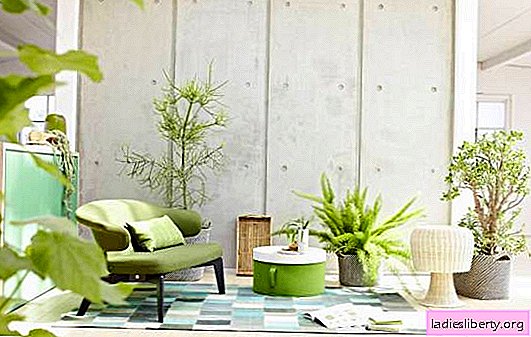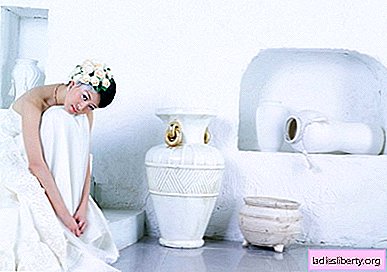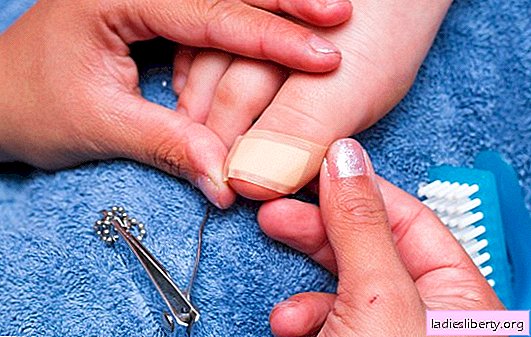
And there can be no question! So that adequate people fill up the windowsills of their apartments with flowers. What is the use of them at all?
How to use indoor plants to improve the air in the apartment?
The average urban resident spends about 80% of his free time indoors. And according to research, the air inside the apartments can be polluted 10 times more than on the street. This becomes one of the reasons for the appearance of a number of respiratory and chronic diseases in people, as well as allergies.
Various chemicals appear in our apartments primarily from the street, tobacco smoke, from building materials, plastic, furniture, various dyes, adhesives, household chemicals, carpets.
Everyone knows the “atmosphere” in new or recently renovated rooms. Oh, that smell of cement, plaster, varnish or paint! A long stay in such places, rest and sleep are especially dangerous for the health of an adult, let alone a child.
In such difficult situations, as always, you can ask for help from the mother of nature. Indoor plants can significantly improve indoor air quality. This is confirmed by NASA research reports. During which, scientists found that plants are able to remove 87% of the toxic substances that are in the air per day. At the same time, for a normal living room, 2-3 large plants are enough.
Plants are able to remove such harmful or toxic substances as: carbon dioxide, ammonia, benzene, xylene, toluene, formaldehyde, trichlorethylene.
Do not think that in your apartment all this is not. For example, a carpet on a floor or wall serves as an excellent dust collector and a nursery of microscopic fauna. Remember how the new furniture smells - this is the evaporation of fresh varnish or glue, the active components of which are various solvents and binders. You may not even notice how you inhale a "bouquet" of toxic substances, dust, spores of mushrooms from a damp corner and bacteria. And your immune system is forced to fight this around the clock.
In addition to removing chemicals, plants evaporate moisture, which moisturizes the air. Everyone knows that in the winter, the incidence of influenza and colds increases. The reason for this is largely the inclusion of central heating and, as a result, increased air dryness. In winter, the humidity in the apartment can drop to 20-30% - this, in combination with heat, is an excellent environment for the development of various pathogens, viruses, ticks, bugs, etc. that we can inhale, for example, from a pillow during sleep .
Studies conducted in Norway have proven the effectiveness of plants. Last By moisturizing the air, they reduce the level of dust and human stress, thereby increasing efficiency and creativity.
On the other hand, during the heating season, plants themselves may suffer from low humidity, so you should take care of them. But usually this happens with a small number of plants in the room. In this case, it is necessary to use other means to increase humidity. The best solution is to purchase a humidifier.
In addition, some plants can secrete biologically active, volatile substances - volatile production. These vital products are used by the plant itself to protect itself, suppress the growth and development of various microscopic fungi and protozoa.
For example, volatile garlic kills many species of protozoa in the first minutes or even seconds. Also, it is worth remembering how much easier it becomes to breathe when on the New Year, a Christmas tree or pine is placed at home. Phytoncides of a pine tree kill a stick of Koch (causative agent of tuberculosis) and E. coli. For this reason, the air in a young pine forest is almost sterile. Of course, no one will constantly keep a living pine at home, but you can get something coniferous or small eucalyptus.
The most useful plants for improving air quality are (in random order):
- Ficus Benjamin
- Hamedorea
- date palm,
- Scheffler
- chlorophytum,
- spathiphyllum,
- sansevieria
- geranium (pelargonium),
- citrus,
- aloe,
- dracaena,
- ivy,
- aglaonema
- philodendron,
- monstera.
In addition to all, caring for plants satisfies the craving for nature, gives pleasure, gives the opportunity to show love, care, and instill a sense of responsibility, for example, in children. But a caring parent must remember that not every plant is easily suitable for a child’s room.
What indoor plants are better not to keep in a living room?
First of all, I want to say about various superstitions and signs associated with indoor plants. The allegations of vampire monsters, ivy husbands, gossip sansevieria, wish-fulfilling plants and so on and so forth are so contradictory that you will search for their ends indefinitely. The meaninglessness and absurdity of such stories is obvious to any sane person.
There is also an opinion that a large number of plants in a room can absorb all the oxygen overnight and you will suffocate. For this reason, some people sleep with their windows open. Indeed, plants breathe at night. Oxygen is necessary to maintain vital processes in low light and the inability of photosynthesis. But the amount of oxygen consumed by the plant is approximately equal to what it gives off during the day, absorbing carbon dioxide. So on this side, the plants are completely harmless.
Most houseplants do not pose any danger. These are our friends, they bring benefits, give positive emotions and health.
It should be noted that every plant on our planet has certain protective mechanisms, that is, it is, to one degree or another, toxic. Many plants are especially poisonous. For the same reason, a fair number of species are used as medicinal. By themselves, they are not dangerous until you touch them or taste them. But who in a sober mind will chew, say, Dieffenbachia? Rub against her? Yes, it, like all aroid ones, contains calcium oxalates, which can cause irritation of the skin, mucous membrane and, when consumed in large quantities, severe poisoning. But a normal person is unlikely to eat breakfast with the leaves of his spathiphyllum.
However, there are still some types of plants that are extremely undesirable to keep at home, in the apartment or with care to cultivate on the site. For example, castor oil. Its fruits contain the protein toxin ricin, which is extremely toxic (6 times more than potassium cyanide) and can generally be used as a chemical weapon. Chilibuha seeds contain strychnine and brucin, rosemary gives poisonous (drunk) honey, touch of ash (flowering, herbaceous plant, not ash tree) can cause photodermatitis.
Datura, lilies of the valley, oleander, euphorbia, sedum, gloriosa, boxwood, passionflower, euonymus, adenium and many other plants are frankly poisonous, but do not pose a direct threat, but require careful handling and appropriate safety measures. When working with such species, you need to wear rubber gloves and safety glasses in order to avoid allergic reactions, burns and contact dermatitis. Obviously, when working with cacti, caution is also necessary. Opuntia glochidia can cause inflammation at the injection site.
It is also noteworthy that conifer, rare species of cacti or, for example, popular in home floriculture coleus, and some other plants contain psychotropic substances. But their pure content is quite insignificant.
In any case, you can avoid any deplorable consequences by telling your household or guests about the properties of your green pets. In the end, put the signs. In addition, it is unlikely that anyone other than pets will be able to eat a large enough amount of leaves, fruits or stems of a poisonous plant for a serious effect. If this happens, wash your mouth, drink plenty of water, clean your stomach and take sorbents. If symptoms of poisoning appear, you should definitely consult a doctor.
For this reason, it is better not to keep poisonous plants in houses where there are pets, but from dieffenbachia or oleander in the nursery it is better to refuse.
Some plants during flowering can exude strong aromas that can cause headache, irritability. For example, lilies, jasmine, gardenia. This should be considered when choosing plants for a house or bedroom.
Use common sense.
What house plants are useful in the nursery?
First of all, it must be said which plants it is better to refuse. The plant in the nursery should not contain toxic substances, be without thorns and have a calm look. It should not be large. The child should not hurt himself, drop (knock over or knock over) himself or be afraid at night. Refrain from ampelous plants. Best of all, if it will be various "grandmother" flowers.
Unpretentious plants, distinguished by their endurance and attractive appearance, even in difficult conditions:
- violets
- balsam,
- chlorophytum,
- begonia,
- hibiscus (young plants),
- sansevieria,
- zygocactus and others
Listen to older children and shop together for new plants. The ones that the child will like. That will be the best. Even if it is from an aroid or some cactus - do not be afraid, you can figure it out together and learn how to properly handle such a plant.
Very rare when it occurs allergy to aspergillus is a fungus that is found in the soil. In this case, it is better not to start plants at all. Either grow them hydroponically or contain orchids, without a substrate.
Ultimately, it's up to you to start green pets at home or not. They bring benefits - this is a universally recognized fact. They create a cheerful atmosphere, improve well-being and microclimate, decorate and revitalize the room. Arguments in favor of plants can be very long. The beauty and joy that they give more than enough cover any risks.











